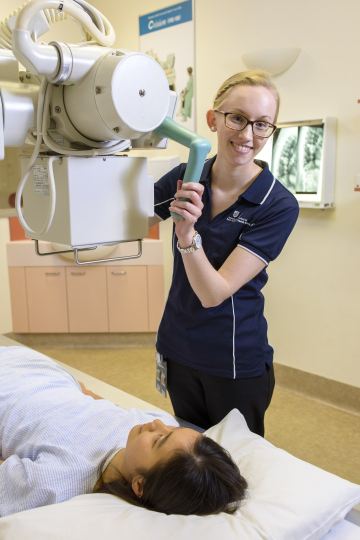Bachelor of Medical Radiation Science (Medical Imaging)
Degree Level Undergraduate
Year 2025
You're considered an International student if you are:
Degree Level Undergraduate
Year 2025
Program Code
IBRS
Prerequisites
None
Assumed Knowledge
None
Fees
AUD$ 44,300 per annum (per 1.0 EFTSL) for students enrolled in 2025
Admissions
Student Profile
International Admission by Country
See full entry requirements
CRICOS Code
088578G
The admission criteria have been grouped to assist you to easily find the information most relevant to your circumstances. However, you may fit into more than one and the university will consider applicants against each of the relevant criteria.
Certain conditions apply. For more information refer to Appendix 4 of the University's Selection and Entry policy.
Applicants are required to meet one of the following criteria with a competitive result, and demonstrate that they fulfil any prerequisite requirements and essential requirements for admission:
Recent secondary education
Meet any prerequisite requirements with a minimum grade of C- or equivalent
AND
Applicants who have not achieved the Selection Rank required for automatic selection may be selected for any remaining places based on the grades of their year 12 subjects.
OR
Higher education study
OR
Vocational Education and Training (VET)
OR
Work and life experience
| Nepal NEB | 3.41 |
| Bangladesh HSC | 5 |
| Canada High School (OSSD) | 90 |
| Eynesbury FSP | 415 |
| German Abitur | 1.8 |
| Kenya KCSE (average) | A |
| Malaysia STPM (best 3) | 12 |
| Malaysia UEC | 20 |
| Norway GPA | 5 |
| Pakistan HSSC | 90 |
| Sri Lanka A Levels (best 3) | 12 |
| Sweden GPA | 18 |
| UK Board GCE A Levels/HK Board | 12 |
| Vietnam | 9.5 |
| Australia | 93 |
| IB (best 6) | 35 |
| USA SAT (1600) | 1465 |
| India (best 4) State Board | 95 |
| India (best 4) Central Board | 85 |
| HKDSE | 22 |
1Results in Clinical Sciences - 2018 Excellence in Research for Australia (ERA). 2ComparED (QILT) Graduate Outcomes Survey 2021-23– Full-time Employment Indicator (Domestic Undergraduate). SA public universities. 3Ranked #43, 2024 THE Young University Rankings.
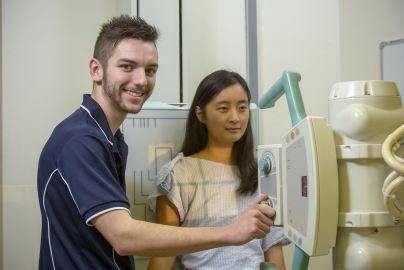
Unleash your unstoppable career in the rewarding and highly specialised field of medical imaging.
As a professional diagnostic radiographer, you will be prepared to work across general radiography practice, including x-ray, fluoroscopy, theatre or emergency imaging. You will be responsible for producing high quality medical images, using various technologies and types of radiation to monitor and help diagnose injuries and illnesses. You will also work as part of an interprofessional team to deliver life-changing outcomes for patients.
We offer South Australia’s only degree to become an accredited medical imaging professional, and will prepare you to confidently join the workforce through a mixture of practical, theoretical, and industry learning.
High achieving students may be considered for the Bachelor of Medical Radiation Science (Honours) (Medical Imaging) program in the third year, where you’ll complete a research project and become prepared for a career in academia.
Students who undertake activities where interaction with patients/the public is required for their degree, such as field or clinical placements/visits and in University clinics and gyms, must demonstrate they meet mandatory pre-placement conditional requirements. These include criminal history clearance, a Working with Children Check and immunisation requirements.
Please visit the Clinical Placement Unit for information on key requirements, and to access the full student checklists.
All students enrolled in a program leading to professional registration must be registered with the relevant national board. The registration process is undertaken by the Australian Health Practitioner Regulation Agency (AHPRA) with the University providing notification to AHPRA following enrolment in the program.
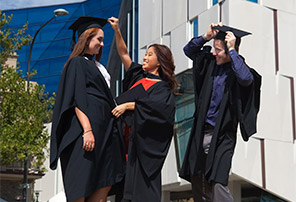
Medical imaging professionals are responsible for producing high quality medical images using various technologies and types of radiation to monitor and help diagnose injuries and illnesses. Their work includes general radiography such as x-rays, fluoroscopy, theatre or emergency imaging.
Throughout your degree, you’ll learn how to produce optimal images using complex equipment while caring for patients. You’ll also complement your clinical skills with valuable interpersonal skills, such as communication and collaboration.
During your first year, you’ll focus on basic sciences at the core of the study and practice of medical radiation science. You’ll cover a range of topics, including anatomy, physiology, pathology and radiation physics. These core subjects introduce you to the scientific principles surrounding medical radiation.
You’ll apply these concepts to professional practice through clinical placements, which begin in your second year and continue through third and fourth years.
Throughout your degree, you’ll also take part in regular pre-clinical preparation workshops to further extend your skills as you move into advanced areas of practice.
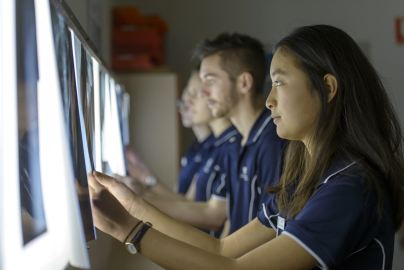
UniSA’s industry-led teaching methods offer you extensive practical learning opportunities, coupled with the support and mentoring from award-winning teaching staff and academics.
UniSA gives you valuable hands-on experience using state-of-the-art imaging facilities on campus. You’ll study a curriculum informed by above world-class research in medical radiation science1, and learn in-demand specialist skills. Further practical experience is gained during more than 1,400 hours of clinical placements in Adelaide metropolitan, rural and interstate settings, ensuring you graduate career ready.
You’ll graduate with eligibility to register with the Medical Radiation Practice Board of Australia (MRPBA).
1Results in Clinical Sciences - 2018 Excellence in Research for Australia (ERA).
Medical radiation professionals are in high demand across South Australia and interstate,1 with strong application into international industry. You may work in a variety of settings, including hospitals and private clinics, medical equipment companies, or can continue into research.
A successful medical imaging professional should enjoy working with people and technology, helping sick or injured people, working a variety of hours, be interested in the human body, being challenged by new ideas, and being part of a team.
Upon graduating, you’ll be eligible for registration with APHRA and can work as a:
Through further postgraduate study or on-the-job training, you may upskill into roles like:
1Australian Government National Skills Commission Employment Projections 2021.
Graduates are eligible to apply for general registration with the Medical Radiation Practice Board of Australia (MRPBA).
How to apply for international students will give you helpful information about the application process at the University of South Australia. When you are ready, apply through our International Application System. If you would like to talk to someone near you about studying at the University of South Australia, we have agents all over the world who can assist you. Find an Education Agent in your country.
Australian
There are other pathways you can follow to study this degree, including:
International
There are other pathways you can follow to study this degree, including:
Every year, over 2,500 UniSA students are supported in their studies through scholarships and grants worth millions of dollars. Check out the scholarships below. One of them may be perfect for you. Visit our scholarships page for more.
Recipients can get a 50% reduction on tuition fees for up to four years of full-time study for selected degrees.
Recipients can get a 15% reduction on tuition fees for the duration of their chosen degree.
As a UniSA student, you will have unique access to work placement opportunities, overseas study tours and exchanges, networking events, internships, guest speakers and more.
Our campuses are equipped with state-of-the-art facilities including modern lecture theatres, libraries, workshops and laboratories, as well as spaces that simulate real work environments. These are all supported by the latest technologies and a 24/7 online learning platform. We have health services on campus, gymnasiums, technology zones and great student lounges. You will also gain access to a range of community clinics, which provide professional and cost effective services in areas of health, business, law and psychology. There are campus sport activities to keep you active, and if you are keen to explore the social side of university life, there are movies, cooking demonstrations, parties and lots more.
Adelaide also has a variety of accommodation options to suit different requirements and budgets. Options include dedicated student accommodation and private rentals. See our long-term accommodation pages, or explore our student accommodation by Scape on Bank Street in Adelaide’s lively cultural precinct, an ideal location for students. It is within easy reach of UniSA’s city and metropolitan campuses, Rundle Mall shopping, the Central Market, Chinatown, and the West End’s vibrant nightlife. It is also across the road from the Adelaide train station, and on bus and tram routes.
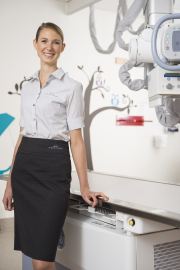
As a medical imaging student, you’ll learn in on-campus medical imaging facilities, including fully functioning, state-of-the-art x-ray suites with associated software packages.
You’ll also be able to access general on-campus spaces including modern lecture theatres, collaborative teaching rooms, and relaxed student lounges.
I’m interested in the application of innovative learning and teaching methodologies within the clinical and academic learning environments, and how these environments interconnect.
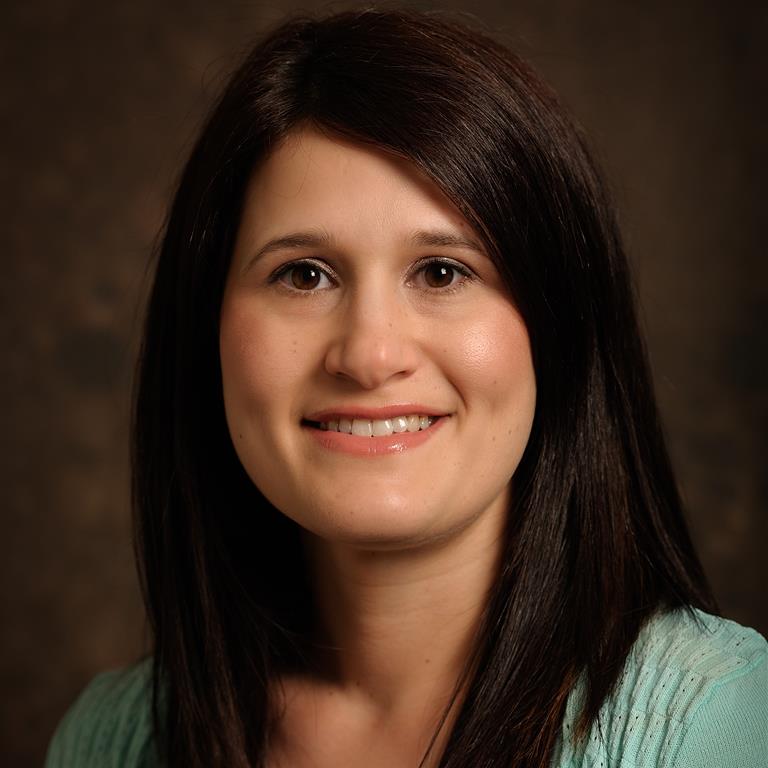
There are a number of ways to apply to study UniSA's undergraduate and postgraduate coursework degrees.
You can access our online International Application System through our How to Apply page. The International Application System is an easy and secure online application and acceptance process. You will have visibility of your application through the secure online portal with the ability to download offer documents, submit your acceptance and make a payment.
Alternatively you can submit an application through one of the University's registered Education Agents.
If you are completing an Australian year 12 qualification in Australia or overseas, or the International Baccalaureate (IB) Diploma Programme in Australia, you must apply through SATAC http://www.satac.edu.au/.
If you are applying for the UniSA Study Abroad or Study Abroad Plus program, you can submit your application online here.
Postgraduate study by research
For information on applying to do postgraduate study by research, including Masters by Research, PhDs or Doctorates, please visit http://unisa.edu.au/resdegrees.
There is no closing date for submitting your application however the admissions process takes between one and three weeks from the date that we receive your application and all required supporting documentation.
If you are completing an Australian year 12 qualification in Australia or overseas, or the International Baccalaureate (IB) Diploma Programme in Australia, you must apply through SATAC. Key dates for applications can be found here.
You may be eligible to receive credit or advanced standing for your chosen UniSA degree based on your previous studies, if they are in a related area at an equivalent or higher level. Receiving credit will reduce the number of courses you undertake within the degree, and may also reduce the overall duration of your degree.
The amount of credit you may be eligible to receive is assessed on a case-by-case basis by the Admissions team.
The best way to determine your eligibility to receive credit or advanced standing is to apply using our International Application System which can be found on our How to Apply page. You will need to supply detailed syllabus documents with your application.
UniSA welcomes the opportunity to speak with you regarding your study options. Our staff are able to talk to you about degree information, career outcomes and pathways, entry requirements, applications, and student life, so that you are able to make the best study decision for your future.
Click here to book a 1:1 appointment with one of our enquiries team.
We also have many events throughout the year in Australia and overseas where you can speak with UniSA representatives about your area of interest. View our calendar of events in your home country by selecting the 'International' filter.
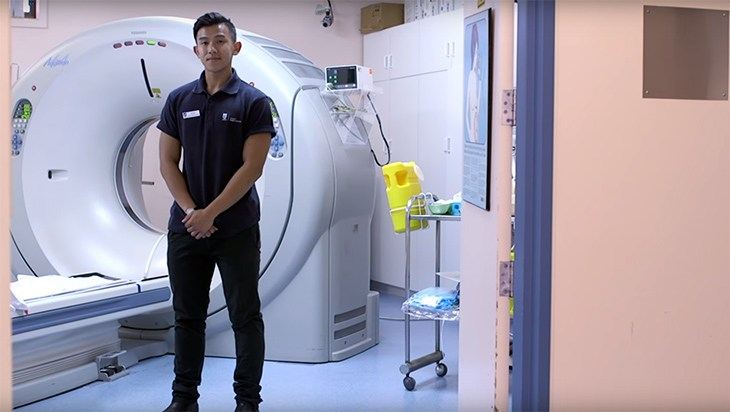
Rural Medical Radiation Science Placement Testimonial - Nathan Ngo


